Mercedosaurus Rex at Indianapolic Park
Part 14: Other bespoke-design 209s
Author
- Henri Greuter
Date
- December 9, 2009
Related articles
- March-Alfa Romeo 90CA - Fiasco Italo-Brittanico, by Henri Greuter
- March-Porsche 90P - The last oddball at the Indianapolis Motor Speedway, by Henri Greuter
- Penske-Mercedes PC23-500I - Mercedosaurus Rex at Indianapolic Park, by Henri Greuter
- Introduction
- Part 1: Penske Racing at Indianapolis - new standards
- Part 2: Ilmor Engineering at Indianapolis
- Part 3: Mercedes, Benz and Mercedes-Benz at Indianapolis up until 1993
- Part 4: Equivalency formulas - waiting for things to go wrong
- Part 5: Stock blocks - keeping them rolling and promoting 'Born in the USA' technology
- Part 6: Indianapolis 1991 - Chevy And Rich Team owners
- Part 7: The Speedway narrowed, its speeds lowered
- Part 8: The forerunner
- Part 9: Pre-May '94 plans
- Part 10: Penske PC23 - a home for the engine
- Part 11: The 1994 Indycar season until mid-April
- Part 12: The unfair advantage and when others have it
- Part 13: Practice during the 1994 'Month of May'
- Part 15: From the last weekend of May '94 to the end of the season
- Part 16: Could the Mercedes Benz 500I have been stopped in time?
- Part 17: Creating an extinct species without it being forbidden, initially at least
- Part 18: The 1995 '500' - Did the Mercedosaurus bite its masters after all?
- Part 19: A possible twist of fate for Rahal-Hogan and Penske as a legacy of the 500I
- Part 20: Re-evaluation of our verdict
- Part 21: PC23's further active career after 1994
- Part 22: USACís points of views and some answers
- Part 23: The loose ends that didnít fit in anywhere else and the epilogue
- Part 24: "Plan your work; work your plan" - Chuck Sprague on the PC23
- Appendix 1: Specifications
- Appendix 2: Car and driver appearances and performances during the Month of May 1994
- Appendix 3: Chassis, entry, practice and race numbers in 1994
- Appendix 4: PC23's 1994 results sans Mercedes Benz 500I
- Appendix 5: PC23's 1995-'96 results sans Mercedes Benz 500I
- Appendix 6: A reflection on the PC23 chassis used by Team Penske in 1994
- Appendix 7: A review of Beast by Jade Gurss
Who?Johnnie Parsons What?Lola-Greenfield T93/01 Where?Indianapolis When?1994 Indianapolis 500 practice (May 14, 1994) |
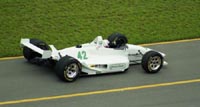 |
Why?
It had been USAC's wish to see more of the smaller engine companies embrace the pushrod rules. In the wave of publicity for the Mercedes Benz 500I, it is almost forgotten that the 500I wasn't the only purpose-built 209 CI pushrod engine to make it to the Speedway. There was one other purpose-design 209 pushrod entered at Indianapolis that year.
Peter Greenfield, a New York-based industrialist owning a company making zinc and aluminum die castings, started a project to build a purpose-design 209 pushrod in June 1991. Greenfield got support from his sons Michael and Douglas. Michael had passed his Indianapolis rookie test in 1989 but failed to qualify for the race that year.
In an interview for the 1994 Carl Hungness Yearbook, Greenfield expressed his surprise it had taken so long for others to do something similar. Greenfield's project lacked the massive input like that of Ilmor but according to Greenfield it didn't contain any parts you could purchase over the counter. The engine was wider at the bottom than the other engines in use, due to the location of pump designs to which the engineers had committed to in an early phase of the design. On the other hand, the engine wasn't as tall as the Mercedes.
The Greenfields had obtained a Lola T93 modified by Riley & Scott Engineering for use with the Greenfield GC 209T V8. The car in question was reported to be an ex-Fabi car, thus a former Jim Hall car. The underwing of the Lola had to be modified because of the wider engine. It is interesting to note that Riley & Scott modified the T93 for the Greenfield. Riley & Scott entered a car of their own in 1994, driven by Jim Crawford, but that car was, on paper, a much lesser opponent, so the heroic Crawford had to do with a 1991-vintage Lola T91-Buick! This meant that Riley & Scott worked on a car on behalf of a customer that was more modern than the one of their own.
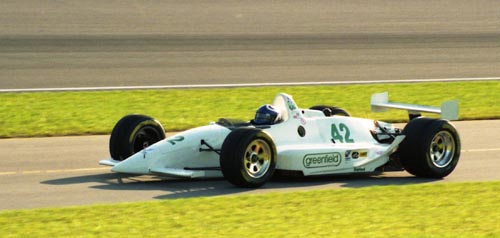
The Lola-Greenfield, seen on Friday May 13th. (photo HG)
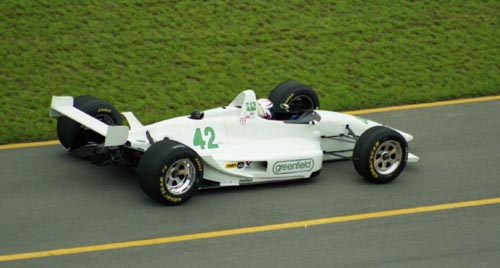
Parsons made some laps on pole day, Saturday, May 14th. (photo HG)
While sorting the package out the electronics especially turned out to be a major problem. According to the 1994 Media Guide power figures were unknown and the engine was estimated being capable of revving up to 11,000rpm. So if true, it was capable of revving faster than the 265E, quite an achievement.
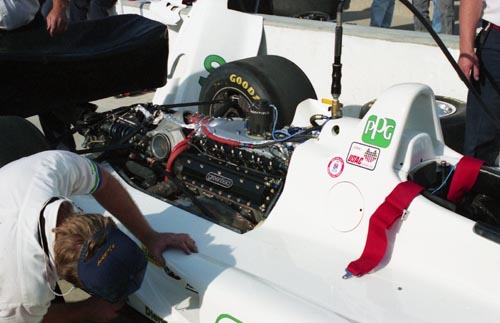
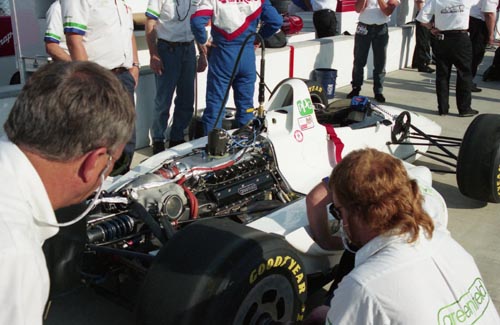
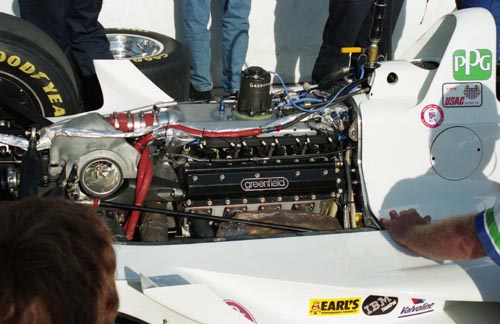
The only occasion I got to see the Greenfield V8 from nearby was on Friday 13th while hanging out on the pit lane. As can be seen, the Greenfield was much lower than the Mercedes 500I. (photos HG)
It had been the team's intention to allow Michael to drive the car that upcoming month of May. But shortly before the Rookie Orientation Program the team lost an engine on the dyno and missed the three-day practice program. Having missed the ROP, Michael was no longer accepted as a driver so the Greenfield team hired Johnnie Parsons to drive the Lola-Greenfield.
The Greenfield-Lola had a fairly hard time at the track. It made its first appearance on May 8th for a total of 12 laps and reached a speed of little over 191mph. It returned on Friday 13th for a mere five laps in which no speed was recorded. One day later Parsons did 14 laps with a top speed of 207.579. Yet another day later Parsons did 13 laps with a highest average of little over 204. The next appearance of the Greenfield was on Saturday May 21st, for a total of 28 laps with a highest average of 205.667. On the final day of qualifying it made its largest number of laps on a single day, 42, with a highest average of 213.756. By far not fast enough to consider a qualifying attempt. According to the 'Month of May Performance History Ė by best speed' Parsons and the Greenfield were listed as 97th fastest out of 109 driver/car combinations registering a time. It should be noted however that Parsons was measured on the straights with speeds of over 220mph. The primary problem was getting the car to handle, not the engine. When the ambient temperature at the track went into the ninety degree (Fļ) range a design fault in the engine management system (ECU) reared its ugly head and effectively ruled out any chance of making a qualifying attempt.
Peter Greenfield admitted he made a mistake by modifying a 1993 Lola since a 1992 Lola was likely to have been more suitable as it accepted larger size engines. (The 'standard' Lola T93 was designed for the new generation of 'micro' engines such as the Cosworth XB and Chevy/C while the T92 was still suitable for the larger-size Chevy/A and DFX/DFS.)
Nevertheless, it was the kind of effort that USAC had envisioned: the 'little man' with a homebuilt car taking on the big teams and factories. Greenfield deserved better with his Greenfield GC 209T engine than what he got. However, what if his engine would have had, one way or the other, the kind of support John Menard gave his Buick-based V6 engines?
The Autocourse 1994 CART yearbook concluded in its Indianapolis chapter that the Greenfield project failed to get the media attention it deserved. Regrettably for Greenfield all the glory and focus went to the Penske team. One year later, however, Greenfield was back with the engine but again failed to qualify.
As a result, few if little is known about the Greenfield engine. When I did more research on this engine I was surprised to learn how little attention this brave effort got in the past and how unknown it is. The lone example of USAC's idolized pet engine formula remains an enigma. I wish I could have added more about this effort here in order to give it and its creators more credit since their work was what USAC wanted to promote but I'm unable to tell anything substantial. Almost all attention devoted to the USAC purpose-built 209 pushrods went to the Ilmor 265E.
If the 'Mercedosaurus Benz' was a tyrant, its biggest victim was anything resembling it close, the Greenfield GC209T in particular.
Mid-April there were still persistent rumours that Honda had a similar 209 CI pushrod engine for use at Indianapolis. Nigel Mansell was reported to have been the most outspoken person spreading this rumour. But according to Robert Clarke, the man running Honda Performance Development Inc. in California, where Honda's Indy engines are maintained, this wasn't true. Clarke stated that Honda was busy making their regular quadcam 161 CI engine run properly although he admitted that should USAC retain the same rules for next year Honda could well be forced to build such an engine, even though he hoped it wouldn't be necessary.
At the time, other companies rumoured to be working on bespoke pushrod V8 engines were Brayton Engineering and Menard. None of these saw the light of day in time for the 1994 Indianapolis 500 but later on more became known about these projects.
